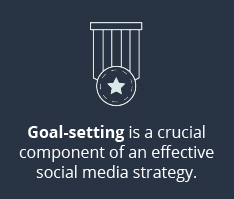In the U.S., people spend an average of about two hours a day scrolling through social media feeds, and the global average is closer to 2.5 hours. These diverse platforms are now some of the most widely used sectors of the internet.
It is no wonder that a strong social media presence is now a crucial component of your brand’s marketing efforts. Yep, even if you’re a B2B company.
If you’re overwhelmed by the fast-paced nature of Facebook, Instagram, Twitter, Snapchat, and TikTok and want to know how to keep up with social media trends, we’ve got you covered. And for businesses that have yet to branch out into the social sphere, we’re here to tell you it’s never too late. Here’s what you should know about building a scalable social media strategy.
Keeping Up With Social Media Best Practices
Do you feel like social media is always changing with new platforms and algorithms coming out every other week? While it’s true the world of social is continuously evolving, it doesn’t mean your marketing efforts will be in vain.
So, how can you keep up without becoming overwhelmed? Reviewing the best practices for social media is a great place to start.
Begin With an Audit
Like all marketing undertakings, we recommend kicking things off with an audit. A social media audit will tell you:
- Who you currently connect with
- Who you could potentially connect with
- Which platforms your target market uses most
- What your competitors are doing on social media
- What results (if any) your current social efforts are yielding
Auditing your social media with a critical eye can be a challenge for a lot of companies. Our team at Mad Fish can do a deep dive into your brand’s social media presence with that objective lens. Using qualitative and quantitative data, we’ll provide you with actionable insights and a suggested plan of action.
Set Meaningful Goals

Since social media is something most of us use in our personal lives, it can be easy to view it as a more casual branding approach. But goal-setting is a crucial component of an effective strategy.
Think about what you want to achieve with social media marketing over the next year. Do you want to increase brand awareness, expand your audience, boost community engagement, or prioritize ethical social media practices? Maybe your goal is to drive more traffic to your website, or perhaps it’s to generate more leads or conversions. In any case, your objectives should be clear, meaningful, and measurable.
Research Your Customer Personas
Another step many marketers skip over is researching audience personas. Though you might think you have a good idea of who your customers are and how they behave online, making assumptions can be a costly mistake.
Whether your target market is focused only on college-age individuals or a mix of Gen Z, Millennials, Gen X, and Boomers, you can find an abundance of demographic information about your audience online. This research will give you super valuable insight into the types of content your audience likes and responds to, as well as which messaging and social media platforms to use.
Do a Competitive Analysis
Similarly, researching your competitors’ social media presence will give you a better understanding of consumers who interact with brands like yours. A competitor analysis can also tell you what types of content perform well and what social channels are most effective for your brands’ goals, whether they’re increasing awareness or driving purchases.
Figure Out Which Platforms to Use
We suggest having multiple active social media pages. However, this doesn’t mean you need to create an account for every single platform. Facebook, Twitter, Instagram, YouTube, LinkedIn, and Pinterest are good standbys. But beyond that, you’ll have to do some digging to identify which mediums are worth the effort.
The best way to figure out which platforms to use is to determine where your target market spends most of their time. Researching audience personas and doing a competitive analysis will give you some insight, but you can always find more data to fill in the blanks.
Fine-Tune Your Playbook
Establishing a social media playbook allows you to fine-tune your brand voice and tone to ensure it’s consistent across all channels. It’ll also help your team get on the same page, which is crucial for any marketing strategy.
Mad Fish can help you create and hone in on a social playbook so you can define your philosophy, streamline your internal processes, get in sync, and solidify your overall approach by aligning your brand with platform personality and voice.
Develop a Posting Schedule
You’ll also want to develop a posting schedule. You can find out when your followers and target audience are most likely to be online and plan social media posts accordingly. If you post at a certain time every day, make sure you track your engagement and adjust your schedule if needed.
Once you’ve put together your posting schedule, it is easy to schedule your posts using platforms like HootSuite or Sprout Social. While it is important to post often, there is a fine line between providing relevant content at the right time and overdoing it.
Many people try to save time by having all of their social media content sync so the same messages appear everywhere. You want to limit this as much as possible. Each platform has a different type of community and a different goal. Even if you are using the same pictures or types of content, vary the messaging used to sync voice and audience on each platform.

Engage With Your Audience
After posting to your social channels, don’t leave your audience hanging. Whether you stay online for an hour after each post or block off a half-hour at the end of the day, it’s important to engage with your audience regularly.
Aside from answering all their questions promptly, you can take things a step further. Respond to all comments, chime in on posts that mention your brand, and craft engaging captions to encourage your audience to interact with your content.
One of the most effective social media tactics is to monitor the top keywords in your industry so when someone mentions them, you can jump in and become part of the conversation. Google Alerts, BrandMentions, and BuzzStream are a few platforms you can use to track keywords.
Double Down on Metrics
No matter what type of business you’re running, your social media approach should be driven by data. This means you should identify your KPIs (key performance indicators) and double down on the metrics that matter. We’re talking engagement rate, post reach, clicks, shares, and hashtag performance.
Partnering with a digital marketing agency like Mad Fish Digital can give you a leg up. We can assist with auditing, audience research, competitor analysis, and social media measurement. Get in touch with us to see if we might be a good fit for your brand.

